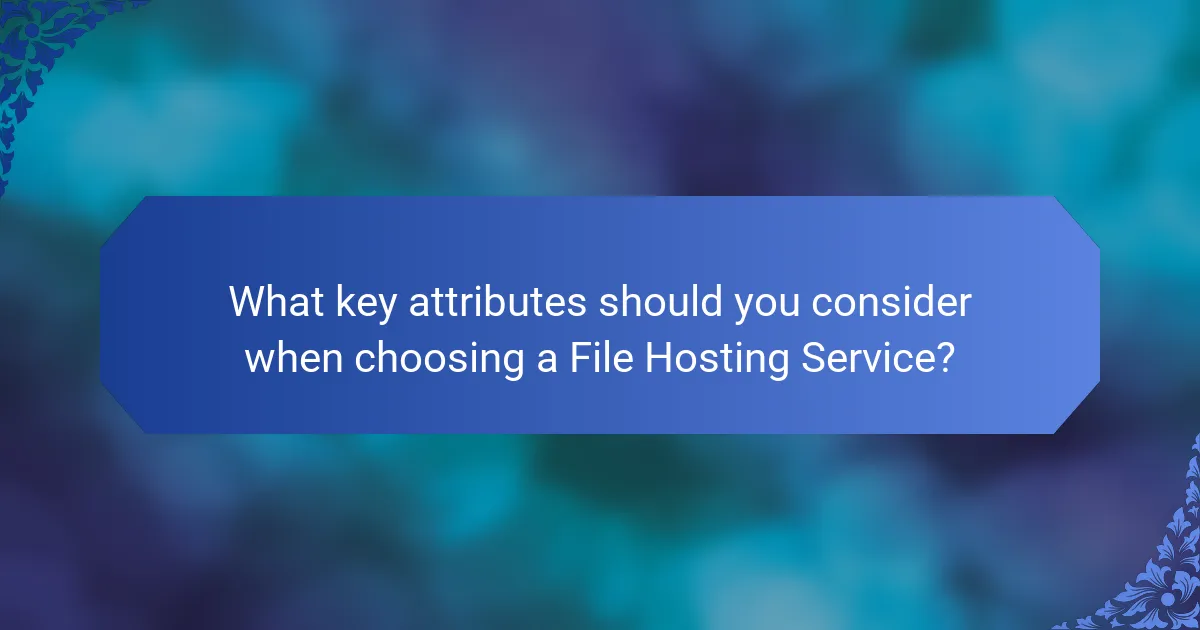A file hosting service is an online platform that enables users to store and share various types of files, including documents, images, and videos, accessible from any internet-connected device. This article outlines essential attributes to consider when selecting a file hosting service, such as storage capacity, security features, and user-friendliness. It also evaluates performance metrics like upload/download speeds, uptime reliability, and user feedback. Additionally, the article explores common pricing models, including subscription-based, pay-as-you-go, and freemium options, helping users make informed decisions tailored to their needs.

What is a File Hosting Service?
A file hosting service is an online platform that allows users to store and share files. These services provide a virtual space for users to upload documents, images, videos, and other types of files. Users can access their files from any device with internet connectivity. File hosting services often offer features like file synchronization, sharing links, and collaboration tools. Many services provide free storage options with limits, while others offer paid plans for additional space and features. Popular examples include Dropbox, Google Drive, and OneDrive. These platforms enhance accessibility and facilitate file management for individuals and businesses.
How do File Hosting Services operate?
File hosting services operate by allowing users to upload, store, and share files over the internet. These services provide a platform where files are stored on remote servers. Users can access their files from any device with internet connectivity. When a user uploads a file, it is transferred to the service’s data center. The file is then stored securely on the provider’s servers. Users can share files through links or by granting access to other users. File hosting services often include features like version control and file synchronization. Many services also offer encryption for data security. According to Statista, the global file hosting services market is projected to grow significantly, indicating widespread usage.
What technologies are used in File Hosting Services?
File hosting services utilize various technologies to store and manage files. These technologies include cloud storage solutions that provide scalability and accessibility. File transfer protocols like FTP and SFTP enable secure file uploads and downloads. Additionally, web-based interfaces allow users to interact with their files easily. Data encryption ensures the security of files during storage and transmission. Content delivery networks (CDNs) enhance file access speed globally. Backup and redundancy technologies protect against data loss. These technologies work together to provide reliable and efficient file hosting solutions.
How do users interact with File Hosting Services?
Users interact with File Hosting Services by uploading, downloading, and sharing files. They access these services through web interfaces or dedicated applications. Users typically create accounts to manage their files securely. They can organize files into folders for better accessibility. File sharing options allow users to send links to others. Users can set permissions to control access to shared files. Many services offer collaboration tools for real-time editing. Analytics features help users track file usage and access.
What are the primary benefits of using a File Hosting Service?
File hosting services provide secure storage for digital files. They allow users to access files from any device with internet connectivity. This flexibility enhances collaboration among teams. Many services offer automated backups, reducing the risk of data loss. File hosting services often include sharing capabilities, simplifying file distribution. They also provide scalable storage options, accommodating growing data needs. Additionally, many services ensure data encryption, enhancing security. These features make file hosting services essential for personal and business use.
How does a File Hosting Service enhance data accessibility?
A File Hosting Service enhances data accessibility by allowing users to store and retrieve files from any internet-connected device. This service provides centralized storage, making it easy for multiple users to access the same files simultaneously. File Hosting Services often include search functionalities, which streamline locating specific documents. They support various file formats, ensuring compatibility across different systems. Additionally, these services typically offer sharing options, enabling users to collaborate efficiently. Security features like encryption further protect data while maintaining accessibility. According to a report by Statista, 70% of businesses use cloud storage solutions for improved data access and collaboration.
What security features do File Hosting Services typically offer?
File hosting services typically offer several key security features. These include encryption, which protects data both in transit and at rest. Many services implement two-factor authentication to enhance account security. Regular backups are common to prevent data loss. Access controls allow users to manage who can view or edit files. Some services provide audit logs to track file access and changes. Additionally, compliance with regulations like GDPR or HIPAA is often a feature. These measures collectively ensure the integrity and confidentiality of user data.

What key attributes should you consider when choosing a File Hosting Service?
Key attributes to consider when choosing a file hosting service include storage capacity, security features, and ease of use. Storage capacity determines how much data you can store. Many services offer plans ranging from a few gigabytes to several terabytes. Security features protect your files from unauthorized access. Look for encryption, two-factor authentication, and data backup options. Ease of use affects how quickly you can upload and manage files. A user-friendly interface can enhance productivity. Additionally, consider sharing options, compatibility with other software, and customer support availability. These factors collectively influence the effectiveness of the file hosting service for your needs.
How important is storage capacity in a File Hosting Service?
Storage capacity is crucial in a File Hosting Service. It determines how much data users can store and manage. Insufficient storage may lead to data loss or the inability to upload new files. Many services offer plans with varying storage limits, catering to different user needs. For example, personal plans often provide less storage than business plans. According to a survey by Statista, 40% of users prioritize storage capacity when selecting a file hosting service. This highlights its significance in user decision-making. Without adequate storage, users may face challenges in data accessibility and sharing.
What are the typical storage limits offered by File Hosting Services?
Typical storage limits offered by file hosting services vary widely. Most services provide free tiers ranging from 2 GB to 15 GB. Paid plans often range from 100 GB to several terabytes. For instance, Google Drive offers 15 GB for free and up to 2 TB for paid plans. Dropbox starts with 2 GB for free and offers up to 3 TB in its premium options. Services like OneDrive provide 5 GB free and up to 6 TB for business accounts. These limits reflect the competitive nature of the file hosting market.
How does storage capacity affect user experience?
Storage capacity directly impacts user experience by determining how much data can be stored and accessed. Limited storage can lead to frustration when users cannot save files or applications. Insufficient capacity may result in slower performance as devices manage available space. Users often experience delays in file retrieval when storage is nearly full. A higher storage capacity allows for seamless multitasking and efficient data management. Studies show that users prefer services offering ample storage, enhancing satisfaction. For example, a survey by Cloud Storage Insights found that 70% of users prioritize storage capacity when selecting a file hosting service.
What role does data security play in selecting a File Hosting Service?
Data security is a crucial factor in selecting a file hosting service. It ensures that sensitive information remains protected from unauthorized access. A file hosting service with strong data security measures employs encryption protocols. These protocols safeguard data both in transit and at rest. Additionally, reputable services implement multi-factor authentication for user access. This adds an extra layer of protection against breaches. Compliance with industry standards, such as GDPR or HIPAA, indicates a commitment to data security. Services that regularly update their security features demonstrate proactive risk management. Overall, robust data security builds trust and confidence in the file hosting service.
What security protocols should you look for in a File Hosting Service?
Look for security protocols such as SSL/TLS encryption in a file hosting service. These protocols ensure data is encrypted during transfer, protecting it from interception. Additionally, check for end-to-end encryption, which secures data both at rest and in transit. Multi-factor authentication adds an extra layer of protection against unauthorized access. Regular security audits and compliance with standards like GDPR or HIPAA indicate a commitment to security. Lastly, data redundancy and backup protocols are essential to prevent data loss. These features collectively enhance the overall security of your files.
How can encryption impact the safety of your files?
Encryption significantly enhances the safety of your files by converting data into a secure format. This process ensures that only authorized users can access the information. When files are encrypted, they become unreadable to anyone without the decryption key. This protects sensitive data from unauthorized access and cyber threats. According to a study by the Ponemon Institute, 70% of organizations experienced data breaches due to insufficient encryption. Thus, implementing encryption is crucial for safeguarding files against potential risks.

How can you evaluate the performance of a File Hosting Service?
To evaluate the performance of a File Hosting Service, consider several key metrics. First, assess upload and download speeds. These speeds indicate how quickly files can be transferred. Second, examine uptime reliability. A high uptime percentage, ideally above 99.9%, shows consistent access to files. Third, evaluate storage capacity. This includes the maximum file size allowed and total storage space provided. Fourth, check for security features. Strong encryption and data protection measures are essential for safeguarding files. Lastly, review user feedback and performance benchmarks. User reviews often highlight real-world performance experiences. According to a 2023 report by TechRadar, services with high user ratings often correlate with better performance metrics.
What factors influence the speed of a File Hosting Service?
The speed of a File Hosting Service is influenced by several key factors. Bandwidth is a primary factor; higher bandwidth allows for faster data transfer rates. Server location also plays a crucial role; proximity to users reduces latency. The server’s hardware specifications, such as CPU and RAM, impact processing speed. Network congestion can slow down file access during peak usage times. File size and type affect upload and download times; larger files take longer to transfer. Lastly, the service provider’s infrastructure, including their network quality and optimization, directly influences performance.
How does bandwidth affect file upload and download speeds?
Bandwidth directly influences file upload and download speeds. Higher bandwidth allows for more data to be transmitted simultaneously. This results in faster file transfers. For example, a connection with 100 Mbps can download a 1 GB file in approximately 80 seconds. Conversely, lower bandwidth, such as 10 Mbps, would take around 13 minutes for the same file. Therefore, the available bandwidth is a critical factor in determining transfer speed.
What is the significance of server locations in performance?
Server locations significantly impact performance by affecting latency and data transfer speeds. Proximity to the end user reduces the time it takes for data to travel. This results in faster loading times for websites and applications. A study by Akamai found that a 100-millisecond delay in load time can decrease conversion rates by 7%. Additionally, server locations can influence bandwidth availability and reliability. Regions with more data centers often provide better redundancy and lower downtime. Therefore, selecting a file hosting service with strategically located servers is crucial for optimal performance.
What types of customer support are important in a File Hosting Service?
Responsive customer support is crucial in a File Hosting Service. It includes multiple channels such as live chat, email support, and phone assistance. These options ensure users can quickly resolve issues. Knowledgeable support staff can provide accurate troubleshooting and guidance. Availability of support should be 24/7 to accommodate different user time zones. Comprehensive FAQs and online resources enhance user self-service capabilities. Timely responses improve customer satisfaction and retention. User feedback on support effectiveness can guide service improvements.
How does 24/7 support impact user satisfaction?
24/7 support significantly enhances user satisfaction by providing immediate assistance whenever needed. Users feel more secure knowing help is available at any hour. This accessibility leads to quicker issue resolution, minimizing downtime. Research indicates that 70% of users prefer services with round-the-clock support. Additionally, consistent support fosters trust and loyalty among users. A responsive support system can lead to higher retention rates and positive reviews. This ultimately contributes to a better overall user experience with the service.
What support channels should be available (e.g., chat, phone, email)?
Support channels that should be available include chat, phone, and email. These channels provide users with multiple options for assistance. Chat support offers real-time responses for immediate inquiries. Phone support allows for direct communication, which can resolve complex issues quickly. Email support provides a written record and is useful for non-urgent questions. Offering these channels enhances user experience and satisfaction. Many file hosting services that prioritize customer support implement these options to meet diverse user needs.

What are the common pricing models for File Hosting Services?
Common pricing models for file hosting services include subscription-based, pay-as-you-go, and freemium models. Subscription-based pricing typically charges users a monthly or annual fee for access to storage and features. This model often provides tiered plans with varying storage limits and additional functionalities. Pay-as-you-go pricing allows users to pay for the storage and services they use, making it flexible for varying needs. Freemium models offer basic storage for free, with optional paid upgrades for additional features or storage. These models are prevalent among popular services like Dropbox and Google Drive.
How do subscription plans differ among File Hosting Services?
Subscription plans among file hosting services vary in terms of storage capacity, pricing, features, and user limits. Some services offer free tiers with limited storage, while others charge monthly or annual fees for enhanced features. Pricing can range from a few dollars per month to hundreds, depending on the storage size and additional functionalities. Features may include file sharing capabilities, collaboration tools, and advanced security options. User limits also differ; some plans allow multiple users while others are designed for individual use. Additionally, certain services may provide unlimited storage or bandwidth, which can significantly influence user choice.
What are the advantages of monthly vs. annual subscriptions?
Monthly subscriptions offer flexibility and lower upfront costs. Users can cancel or change plans easily. This is beneficial for those unsure about long-term commitment. Annual subscriptions typically provide cost savings over time. Users often receive discounts compared to monthly payments. This is attractive for those who are confident in their choice. Annual plans also reduce the frequency of payment processing. This can simplify budgeting and reduce transaction fees. Overall, monthly subscriptions are ideal for flexibility, while annual subscriptions favor cost savings.
How do free plans compare to paid plans in terms of features?
Free plans typically offer limited features compared to paid plans. Free plans often restrict storage capacity, with limits around 2GB to 15GB. They may also lack advanced functionalities like file versioning or collaboration tools. Paid plans generally provide increased storage, often exceeding 100GB. Additionally, paid plans may include enhanced security features such as encryption and priority customer support. Users on paid plans often benefit from ad-free experiences and faster upload/download speeds. These distinctions help users choose a plan that meets their specific needs.
What additional features can enhance your File Hosting experience?
Additional features that can enhance your file hosting experience include advanced security options, user-friendly interfaces, and file versioning capabilities. Advanced security options, such as end-to-end encryption, protect your files from unauthorized access. User-friendly interfaces simplify navigation and file management, making it easier to upload and share files. File versioning capabilities allow you to track changes and restore previous versions of documents. Integration with third-party applications can also streamline workflows and improve productivity. Additionally, mobile access enables you to manage files on the go. These features collectively improve usability and security, making file hosting more efficient and reliable.
How do collaboration tools integrate with File Hosting Services?
Collaboration tools integrate with file hosting services by enabling seamless file sharing and real-time collaboration. These tools often utilize APIs to connect with file hosting platforms. This integration allows users to access, edit, and share files directly within the collaboration tool interface. For instance, tools like Slack or Microsoft Teams can link to Google Drive or Dropbox. This functionality enhances productivity by reducing the need to switch between applications. Additionally, integration ensures that all team members have access to the latest file versions. Studies show that organizations using integrated collaboration tools and file hosting services experience improved workflow efficiency.
What is the importance of file versioning in a File Hosting Service?
File versioning in a File Hosting Service is crucial for data management and recovery. It allows users to track changes made to files over time. This feature enables easy restoration of previous versions if errors occur. Users can access different iterations of a document, ensuring that important information is not lost. Versioning also aids in collaborative environments, where multiple users may edit files. It helps maintain clarity regarding who made changes and when. According to a study by the International Journal of Information Management, effective version control reduces data loss incidents by up to 30%. Therefore, file versioning enhances overall data integrity and user confidence.
What tips can help you choose the right File Hosting Service?
Evaluate storage capacity. Choose a service that meets your needs for file size and volume. Many services offer plans ranging from a few gigabytes to several terabytes.
Consider security features. Look for encryption options and two-factor authentication. These features protect your files from unauthorized access.
Assess ease of use. A user-friendly interface simplifies file management. Check for drag-and-drop functionality and mobile accessibility.
Examine sharing options. The best services allow you to share files easily. Look for customizable permissions for collaborators.
Review customer support. Reliable support is crucial for resolving issues. Check for available channels like chat, email, or phone.
Compare pricing plans. Ensure the service fits your budget. Some services offer free tiers with limited features.
Research user reviews. Feedback from other users provides insights into reliability and performance. Look for consistent positive experiences.
Check integration capabilities. Ensure compatibility with other apps you use. Many services integrate with productivity tools, enhancing workflow.
The main entity of the article is “File Hosting Service.” This article provides a comprehensive guide on selecting the right file hosting service, emphasizing key attributes such as storage capacity, security features, ease of use, sharing options, and customer support. It discusses the operational aspects of file hosting services, the technologies involved, and the benefits they offer for both personal and business use. Additionally, the article outlines common pricing models and additional features that can enhance the user experience, helping readers make informed decisions when choosing a file hosting solution.
